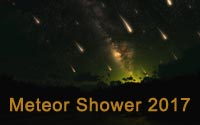Meteor showers are great showy celestial events where a number of meteors descend or radiate from a single point in the sky. It is found that meteors entering the Earth's atmosphere spew streams of cosmic debris called meteoroids that travel on parallel paths and at high speeds. They are also called as shooting stars or falling stars by layman. Most of them of very tiny pieces that they disintegrate during the journey and are gone before they enter the earth.
Some of the notable meteor showers are the Perseids, and the Leonids. The Perseids are visible all through the year and peak during mid-August. The Leonids are called the King of Meteor showers and peak around mid-November. Scan the north sky to view the Leonids. Driving south may lead you to darker skies, but the glow will dominate the northern horizons. Perseid meteors would be seen as a rain in the north east direction and can be viewed around midnight during mid-August. The visiting meteors are visible when they are around 60 miles of 96.5 kms up. Meteors travel at a speed of about 30,000 mph or 48,280 kph and can reach temperatures of about 3000 Fahrenheit or 1648 degrees Celsius.

The meteor showers listed here are the easiest to observe and provide the most activity. Particular attention should be noted to the time and moonlight conditions. All these showers are best seen after midnight. Some are not even visible until after midnight. While the time each shower is best seen remains much the same year after year, the moonlight conditions change considerably from one year to the next.
Quadrantids 2017 Quadrantid meteor shower will be peaked on 3rd and 4th January but it will be visible on 1-5 January 2017. One can see upto 40 meteors per hour during peak. Meteors seems to radiate from the constellation Bootes, close to the North Star. In 1932, the Quadrantid meteor shower showed maximum activity with 80 meteors per hour.
Lyrid meteor shower Lyrid is a medium intensity meteor shower. It usually produces about 20 meteors per hour in its peak. The shower will peak on 21-22 April but some meteors will be visible between 16 to 25th April. Meteors seems to radiate from the constellation Lyra.
Eta Aquarid meteor shower Eta Aquarid is a low intensity meteor shower. It usually produces about 10 meteors per hour in its peak. The shower will peak on 5-6 May. Meteors seems to radiate from the constellation Aquarius.
Perseid meteor shower Perseids are one of the strong meteor showers. It produce up to 60 meteors per hour at peak hours. Radiant point of this shower is in the constellation Perseus. These meteors originate from the tail of comet Swift-Tuttle.
Orionid meteor shower Orionid is a medium intensity meteor shower and one can see about 25 meteors per hour.
Leonids meteor shower Annual event of Leonid meteor shower can be seen on 16-17th November. Leonid meteor shower is visible towards the constellation Leo, the Lion. During Leonid meteor shower, Earth will pass through a stream of debris which is left behind by comet Tempel-Tuttle.
Geminids meteor shower Geminids meteor shower is a strong meteor shower. Annual event of Geminids meteor shower take place on 13-14th December but some meteors will be visible between 6 to 19th December. For many observers, geminid is the best meteor shower. It can produce 60-80 meteors per hour at its peak.
Ursids meteor shower Ursids meteor shower is a medium intensity meteor shower. Ursids meteor shower peaks on 22-23 December. It usually produces 5-10 meteors per hour but occasionally it can produce about 100 meteors per hour.